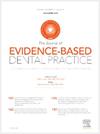The Desensitizing Effect of Nanosilver Fluoride Compared to Photobiomodulation Therapy in Molar-Incisor Hypomineralization: A Randomized Clinical Trial
IF 4
4区 医学
Q1 DENTISTRY, ORAL SURGERY & MEDICINE
引用次数: 0
Abstract
Objectives
Molar-incisor hypomineralization (MIH) can cause hypersensitivity. This study compared nanosilver fluoride (NSF) and photobiomodulation therapy (PBMT) regarding desensitization in MIH-affected first permanent molars (FPMs) and plaque reduction.
Methods
Children aged 7-10 years, with 120 hypersensitive MIH-affected FPMs, were randomly assigned to receive NSF or PBMT. Hypersensitivity was assessed using the Schiff Cold Air Sensitivity Scale (SCASS) at baseline, after 15 minutes and 1 month. Plaque accumulation was assessed using the modified plaque index (PlI) of Silness and Löe at baseline and after 1 month. T-test and Mann–Whitney U test were used to compare groups. Intragroup comparisons were done using paired t-test and Friedman test. Multilevel ordinal logistic regression analysis was used to assess the effect of treatment on the outcomes, controlling for confounders.
Results
The study included 40 children, mean ± SD age = 8.03 ± 1.13 years. There was significantly less sensitivity and greater plaque reduction in the NSF than the PBMT group after 1 month (P < .05). NSF and PBMT significantly reduced sensitivity over time (P < .001), with the lowest scores after 1 month. In multilevel regression, NSF was associated with significantly less sensitivity than PBMT after 1 month (AOR = 0.18, 95% CI: 0.07, 0.51, P = .001). While both groups had reduced plaque accumulation, the decrease was significant only in the NSF group (P < .001).
Conclusion
NSF and PBMT reduced sensitivity associated with MIH and provided immediate pain relief. However, NSF was superior due to its longer-lasting effects on sensitivity and additional benefit in plaque reduction.
Clinical significance
NSF offers a promising alternative to PBMT in desensitizing MIH-related hypersensitivity, particularly for patients with limited access to laser therapy.
Trial registration
The trial was registered in the clinicaltrials.gov registry (# NCT06348849).
纳米氟化银与光生物调节治疗在磨牙-切牙低矿化中的脱敏效果:一项随机临床试验
目的磨牙-切牙低矿化(MIH)可引起过敏反应。本研究比较了纳米氟化银(NSF)和光生物调节疗法(PBMT)对mih影响的第一恒磨牙(FPMs)脱敏和斑块减少的影响。方法选取7 ~ 10岁的120例伴有mih过敏的fpm患儿,随机分为NSF组和PBMT组。在基线,15分钟和1个月后,使用希夫冷空气敏感性量表(SCASS)评估超敏反应。在基线和1个月后,使用改良斑块指数(PlI) Silness和Löe评估斑块积累。组间比较采用t检验和Mann-Whitney U检验。组内比较采用配对t检验和Friedman检验。采用多水平有序逻辑回归分析来评估治疗对结果的影响,控制混杂因素。结果纳入40例儿童,平均±SD年龄 = 8.03±1.13岁。1个月后,与PBMT组相比,NSF组的敏感性明显降低,斑块减少明显增加(P <;. 05)。NSF和PBMT随着时间的推移显著降低了敏感性(P <;.001), 1个月后得分最低。在多水平回归中,1个月后NSF的敏感性明显低于PBMT (AOR = 0.18,95% CI: 0.07, 0.51, P = .001)。虽然两组都减少了斑块的积累,但只有NSF组的减少是显著的(P <;措施)。结论nsf和PBMT降低了与MIH相关的敏感性,并能立即缓解疼痛。然而,NSF的优势在于其对敏感性的持久影响和对斑块减少的额外益处。临床意义:在脱敏mih相关的超敏反应方面,特别是对于激光治疗有限的患者,nsf提供了一种有希望的替代PBMT。试验注册该试验已在clinicaltrials.gov注册中心注册(# NCT06348849)。
本文章由计算机程序翻译,如有差异,请以英文原文为准。
求助全文
约1分钟内获得全文
求助全文
来源期刊

Journal of Evidence-Based Dental Practice
DENTISTRY, ORAL SURGERY & MEDICINE-
CiteScore
6.00
自引率
16.70%
发文量
105
审稿时长
28 days
期刊介绍:
The Journal of Evidence-Based Dental Practice presents timely original articles, as well as reviews of articles on the results and outcomes of clinical procedures and treatment. The Journal advocates the use or rejection of a procedure based on solid, clinical evidence found in literature. The Journal''s dynamic operating principles are explicitness in process and objectives, publication of the highest-quality reviews and original articles, and an emphasis on objectivity.
 求助内容:
求助内容: 应助结果提醒方式:
应助结果提醒方式:


